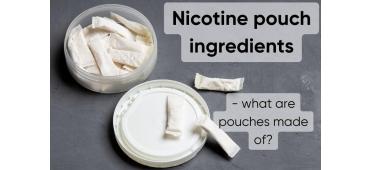Nicotine pouches are becoming one of the most used nicotine-containing products in the US. Brands like ZYN and On! are prospering. The most common questions for those new to the product are: what are nicotine pouches, how are they made, and what do they contain? This article contains everything, from what nicotine pouches are to the nicotine source used in every portion.
What is inside every nicotine pouch?
Nicotine pouches contain different substances that determine the flavor, strength, and intensity of the experience. Below is a list of the components that comprise the nicotine pouch contents in the first step of the production process (found further down the article).
- Nicotine (synthetically made or tobacco-derived)
- Flavorings and sweeteners
- Plant-based materials (Fillers)
- pH adjuster
- Water
What’s the need for a pH stabilizer?
Research states that the pH of nicotine dictates the rate at which nicotine enters your mucosa and then your bloodstream. In effect, the pH determines the intensity of the nicotine release and sensation. But what pH is needed?
A slightly alkaline pH is required for the nicotine to pass into your body in its unionized form. A common pH stabilizer used in nicotine pouches is Sodium Bicarbonate.
There is a sweet spot with pH, as too much alkalinity becomes an oral irritant, hence the strict regulation around this.
What is the difference between synthetic and tobacco-derived nicotine?
Interestingly, the nicotine salt in the pouches can be from different sources. Either tobacco-derived or synthetically made. But what’s the difference between the two, and is one better than the other?
Tobacco-derived nicotine:
- Nicotine is extracted from the tobacco plant.
- It contains some impurities in tobacco, resulting in a bitter, tobacco-like taste.
Synthetic nicotine:
- The majority of synthetic nicotine is made by performing several chemical reactions on nicotinic acids, such as vitamin B3.
- The FDA has approved synthetic nicotine but has not yet determined whether it is less toxic than natural nicotine.
Brands like ZEO nicotine pouches use synthetic nicotine, providing a different and unique selling point compared to your more popular brands like Rogue.
ZYN ingredients Vs On! ingredients: do they differ?
ZYN and On! are two of the biggest brands in the US. The variation in the nicotine pouch market and between the two brands is vast due to the variabilities of the product, including nicotine content, flavor, pouch size, and moisture. However, do these characteristics change the type of ingredients that are within them?
The same types of ingredients mentioned above are in all nicotine pouches. The type and ratios of each may differ depending on the product and brand.
What about the exact compounds in ZYN and On!? Are they the same between the two brands? Below is a table allowing you to compare.
|
ZYN nicotine pouches |
On! Nicotine pouches |
|
Nicotine salt |
Nicotine salt |
|
Stabilizer (Hydroxypropyl cellulose) |
|
|
Fillers (Crystalline cellulose, maltitol, and gum arabic) |
Fillers (Cellulose powder and maltitol) |
|
pH adjuster (Sodium carbonate and Sodium bicarbonate) |
pH Adjuster (Sodium carbonate) |
|
Sweetener (Acesulfame K) |
Sweetener (Acesulfame K) |
|
Flavorings |
Both brands contain very similar ingredients, with minor differences being flavorings and stabilizers. This is the case amongst all brands available.
How is a nicotine pouch made?
The manufacturing process of the nicotine pouch is automated to ensure the creation of a high-quality product that’s repeatable. It can be summarized into a series of steps below, giving you a detailed knowledge of the production process.
- Preparation of raw materials - nicotine salt, fillers, pH stabilizers, and plant fibers are pre-mixed and ready to be inserted into the portions.
- Pouch formation - A packing machine packs the portions with the premixed filling.
- Pouch packing - The nicotine pouches are packaged into cans.
- Can labeling - The cans are labeled using robotic machinery.
- Correct storage - The nicotine pouch cans are collected and stored correctly at the right temperature until shipped.
Different manufacturers may have slightly different steps but this is a general overview of how these tasty products are made before they are enjoyed by users across the globe.


















